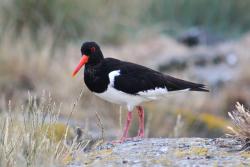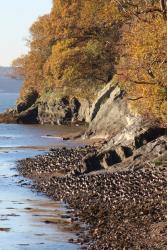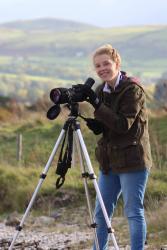Don’t disturb the sleeping oystercatchers
Zoologists from Bangor University have shown how human activity could be disturbing oystercatchers, a near-threatened British bird.
Published in the Journal of Zoology The Eurasian oystercatcher: Image courtesy: Meaghan McBlain the research studied to what extent these birds have their sleep disturbed by walkers and their dogs, and by more distant noises from passing boats, and what effect this might be having on both their need for sleep and their alertness to any threats.
The Eurasian oystercatcher: Image courtesy: Meaghan McBlain the research studied to what extent these birds have their sleep disturbed by walkers and their dogs, and by more distant noises from passing boats, and what effect this might be having on both their need for sleep and their alertness to any threats.
Sleep is an essential behaviour which allows animals to conserve energy but is under researched in wild animal populations.
Meaghan McBlain, who conducted the reserch as part of her MZoo degree explains:
“I recording the eye movements of nearly 300 sleeping birds for short durations over a four-month period. The birds have evolved an eye-blinking strategy called ‘peeking’, where they can periodically open one eye during sleep to monitor their surroundings for potential threats.”
Assessing the ‘peeking’ frequency and length during sleep under different conditions, the researchers found the presence of people with dogs led to less sleep overall as birds increased the frequency and duration of eye-opening.
On hearing passing boats, the birds ‘peeked’ more often but for shorter time periods.
T Roosting oystercatchers above the tide line at Beaumarishe birds also closely monitored their immediate neighbours and slept less when their neighbours were awake. Overall, the oystercatchers would sleep more when surrounded by a greater number of birds as individuals shared the task of monitoring the surroundings for potential threats.
Roosting oystercatchers above the tide line at Beaumarishe birds also closely monitored their immediate neighbours and slept less when their neighbours were awake. Overall, the oystercatchers would sleep more when surrounded by a greater number of birds as individuals shared the task of monitoring the surroundings for potential threats.
Co-author, Dr Graeme Shannon, a lecturer in animal behaviour explained:
“Sleep is an important function and over time, disturbance could cause fitness implications, particularly when resources are scarce during winter when energy demands are high.”
He added: “It may be that a lower level of disturbance during ‘lock-down’ coinciding with the breeding season may have been beneficial, but it is too early to tell whether these will translate into population-level increases, particularly given that the declines we are witnessing have been taken place over decades.”
Dr Katherine Jones, a zoology lecturer and co-author added:
“This research by Bangor University plays an important role within understanding the behaviour of wild animals, especially for those which are in continued decline like the oystercatcher.”
Meaghan conducted her surveys at Morfa Madryn near Llanfairfechan and at Beaumaris. She was supervised by Dr Graeme Shannon and Dr Katherine Jones at the University’s School of Natural Sciences and completed this research as a part of her Master of Zoology degree at Bangor University in 2017.
She says:
“ Meaghan undertaking fieldwork.I first knew of Bangor University because of its reputation for its research in the natural sciences. Once I saw how picturesque the area was on an open day and I heard about the strong sense of community, I was sold!
Meaghan undertaking fieldwork.I first knew of Bangor University because of its reputation for its research in the natural sciences. Once I saw how picturesque the area was on an open day and I heard about the strong sense of community, I was sold!
The course provided me with a deep understanding of the biological world, countless practical skills and, most importantly friends for life.”
Since graduation Meaghan joined a team of rangers on the Farne Islands monitoring seabirds for the National Trust. After two seasons working with iconic species, such as the Atlantic puffin and Arctic tern, she progressed into ecological consultancy where she further developed her understanding of British fauna and flora.
Meaghan currently works within education and hopes to inspire a next generation of scientists.




